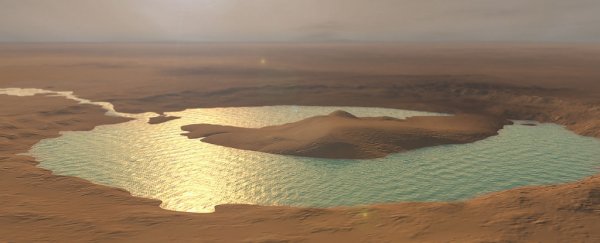From its red and rugged surface, Mars looks like a lifeless planet, both dry and desolate. But that hasn't always been the case.
NASA's Curiosity Rover has now collected even more evidence of an ancient salty lake that once lapped the edges of the Gale crater some 3.7 billion years ago.
Analysing soil samples collected from the crater's bedrock, researchers from Caltech have turned up a diverse range of salts not observed in other rocks on Mars.
Dating back roughly 3.3 to 3.7 billion years ago, the team proposes that these sulfates are left over from evaporated water, indicating the existence of ancient brines, or salty pools, that could have once held tiny forms of life.
Satellite observations of the Red Planet certainly suggest that during this time frame, known as the Hesperian period, some sort of climatic transition took place. And now, the discovery of evaporated salts also indicates a shift to more arid weather on a similar timeline.
The calcium and magnesium sulfates discovered are predicted to have come from Martian basalts, producing soils rich in sulfate and chloride and poor in iron.
"The relatively low solubility of calcium sulfate minerals results in their widespread production during evaporation," the authors explain, "while less common magnesium sulfate and chloride minerals represent terminal evaporation."
Other examples of such hypersaline lakes are known to house salt tolerant or 'halotolerant' biota on Earth, so after these results, the search for life in Gale crater will no doubt continue.
Formed by a meteor roughly 3.5 to 3.8 billion years ago, Gale Crater was chosen as the landing site for Curiosity because scientists suspected, even from afar, that it was a dried-up lake bed.
It turns out, that wasn't such a bad hunch. Ever since it landed, Curiosity's finds have strongly supported the lake hypothesis. In 2013, NASA announced that Gale crater once contained ancient freshwater lake that might have held microbial life. And in the following years, scientists have noticed even more clues of lakes and streams on the Red Planet.
Nevertheless, this is the very first time a sulfate-enriched bedrock has been discovered in the sedimentary record of the crater. As such, it gives us some much-needed clues about how Mars might have lost its water long, long ago.
The authors argue the sulfates, found in several discrete beds, were probably deposited along shallow lake margins with the "potential for segmentation of the Gale lake into discrete ponds, including those where extremely evapo-concentrated brines might form".
Researchers from the University of Chicago and the University of Pennsylvania have also used recent data from the crater bed to propose something similar.
As the rover continues to traverse up the edges of the crater, moving towards younger and younger rocks, scientists will be able to trace the origins of this lake even more fully.
If the salts continue to occur, then the Caltech researchers say this probably indicates they were deposited over several different stages either cyclical or episodic in nature. Whereas if the sulfate-enriched bedrock starts to thin out, then it could imply a longer dry-out of the Red Planet all those billions of years ago.
The research was published in Nature Geoscience.
